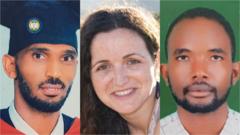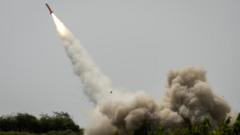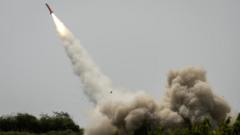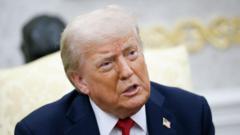Dmitriy Kurashov’s case brings forth broader implications of accountability and protective measures in ongoing conflict zones.
Russian Soldier Faces Trial for Alleged Battlefield Execution in Ukraine
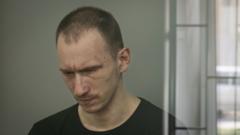
Russian Soldier Faces Trial for Alleged Battlefield Execution in Ukraine
A historic trial unfolds as a Russian soldier is accused of executing a Ukrainian POW amid rising war crime charges.
In the shadows of an enduring conflict, Zaporizhzhia has become the focal point of a landmark war crimes trial. Dmitriy Kurashov, a Russian soldier, stands accused of executing a Ukrainian soldier, marking the first case of its kind in Ukraine since the onset of Russia's full-scale invasion. On January 6, 2024, the battlefield turned brutal as Kurashov's unit, part of the controversial "Storm-V" detachment primarily composed of released convicts, engaged in a confrontation that ultimately led to the execution of Vitalii Hodniuk, a seasoned Ukrainian with the callsign 'Penguin'.
January 2024 saw Ukrainian soldiers mourn the losses inflicted by the Russian assault, an event captured starkly on camera as one soldier named fallen comrades amid the devastated landscape. Fast forward to January 2025, Kurashov found himself in a rundown courthouse, flanked by Ukrainian soldiers while a rottweiler watched closely. Unlike his fellow combatants, Kurashov would face legal repercussions for his actions on the battlefield, while his counterparts had opted to testify against him.
The trial, laden with gravity, has revealed a harrowing narrative of battlefield conduct, where Kurashov, who had initially claimed innocence, altered his plea to guilty in a tactical maneuver to expedite proceedings, still maintaining a semblance of innocence. The prosecution argues that he shot Hodniuk in cold blood as the Ukrainian emerged unarmed, while Kurashov contended that another soldier pulled the trigger.
Alarming statistics surface as the United Nations reports an increase in battlefield executions by Russian forces, with evidence uncovered detailing unlawful killings. This trial serves not only as a measure of justice but as a reflection of Ukraine’s commitment to investigate and prosecute violations of international law, despite being the victim of aggression.
The circumstances surrounding Hodniuk's death have been meticulously examined by Ukraine's SBU, bringing together a wealth of testimony from witnesses and detailing the psychological and ethical implications of the war on both Russian and Ukrainian soldiers. While Kurashov's account claims a lack of training on humane treatment, witnesses offer testimonies that directly contradict his assertions.
The stakes are exceedingly high for Kurashov, who could face a life sentence if convicted. However, the complexities of his situation unfold within an intricate web of military protocols and personal histories, revealing the desperation of those swept into the conflict. As the trial continues, the implications ripple beyond the courtroom, addressing the broader issues of accountability and human rights amidst an ongoing war that has upturned lives and families.
As Kurashov's trial progresses, the enduring pain of war resonates, as families of the executed and those affected by conflict yearn for resolution and justice in an environment defined by turmoil and loss. The haunting reminders of the individuals involved, like Hodniuk, persist long after the last witness has spoken or the court has rendered its verdict.
January 2024 saw Ukrainian soldiers mourn the losses inflicted by the Russian assault, an event captured starkly on camera as one soldier named fallen comrades amid the devastated landscape. Fast forward to January 2025, Kurashov found himself in a rundown courthouse, flanked by Ukrainian soldiers while a rottweiler watched closely. Unlike his fellow combatants, Kurashov would face legal repercussions for his actions on the battlefield, while his counterparts had opted to testify against him.
The trial, laden with gravity, has revealed a harrowing narrative of battlefield conduct, where Kurashov, who had initially claimed innocence, altered his plea to guilty in a tactical maneuver to expedite proceedings, still maintaining a semblance of innocence. The prosecution argues that he shot Hodniuk in cold blood as the Ukrainian emerged unarmed, while Kurashov contended that another soldier pulled the trigger.
Alarming statistics surface as the United Nations reports an increase in battlefield executions by Russian forces, with evidence uncovered detailing unlawful killings. This trial serves not only as a measure of justice but as a reflection of Ukraine’s commitment to investigate and prosecute violations of international law, despite being the victim of aggression.
The circumstances surrounding Hodniuk's death have been meticulously examined by Ukraine's SBU, bringing together a wealth of testimony from witnesses and detailing the psychological and ethical implications of the war on both Russian and Ukrainian soldiers. While Kurashov's account claims a lack of training on humane treatment, witnesses offer testimonies that directly contradict his assertions.
The stakes are exceedingly high for Kurashov, who could face a life sentence if convicted. However, the complexities of his situation unfold within an intricate web of military protocols and personal histories, revealing the desperation of those swept into the conflict. As the trial continues, the implications ripple beyond the courtroom, addressing the broader issues of accountability and human rights amidst an ongoing war that has upturned lives and families.
As Kurashov's trial progresses, the enduring pain of war resonates, as families of the executed and those affected by conflict yearn for resolution and justice in an environment defined by turmoil and loss. The haunting reminders of the individuals involved, like Hodniuk, persist long after the last witness has spoken or the court has rendered its verdict.







